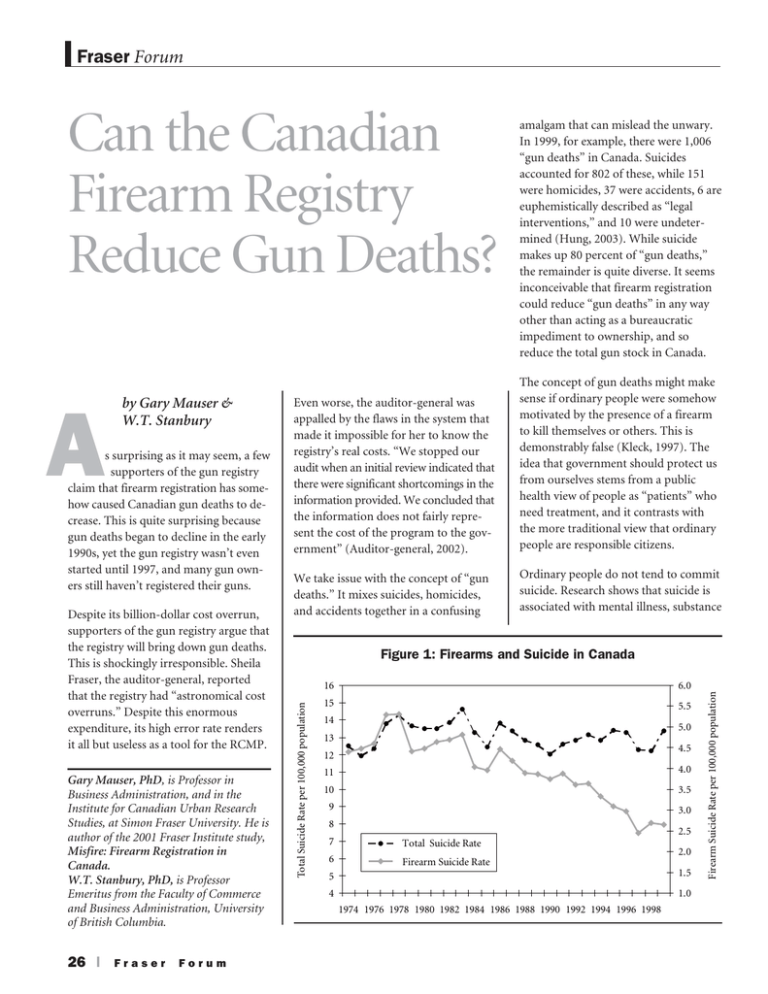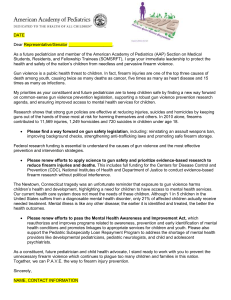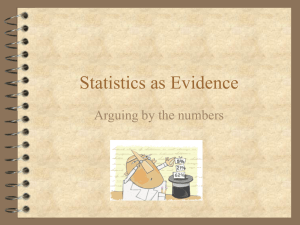Can the Canadian
advertisement

Fraser Forum Can the Canadian Firearm Registry Reduce Gun Deaths? Despite its billion-dollar cost overrun, supporters of the gun registry argue that the registry will bring down gun deaths. This is shockingly irresponsible. Sheila Fraser, the auditor-general, reported that the registry had “astronomical cost overruns.” Despite this enormous expenditure, its high error rate renders it all but useless as a tool for the RCMP. Gary Mauser, PhD, is Professor in Business Administration, and in the Institute for Canadian Urban Research Studies, at Simon Fraser University. He is author of the 2001 Fraser Institute study, Misfire: Firearm Registration in Canada. W.T. Stanbury, PhD, is Professor Emeritus from the Faculty of Commerce and Business Administration, University of British Columbia. 26 | Fraser Forum We take issue with the concept of “gun deaths.” It mixes suicides, homicides, and accidents together in a confusing Ordinary people do not tend to commit suicide. Research shows that suicide is associated with mental illness, substance Figure 1: Firearms and Suicide in Canada 16 6.0 15 5.5 14 5.0 13 4.5 12 11 4.0 10 3.5 9 3.0 8 2.5 7 Total Suicide Rate 6 Firearm Suicide Rate 2.0 1.5 5 4 1.0 1974 1976 1978 1980 1982 1984 1986 1988 1990 1992 1994 1996 1998 Firearm Suicide Rate per 100,000 population s surprising as it may seem, a few supporters of the gun registry claim that firearm registration has somehow caused Canadian gun deaths to decrease. This is quite surprising because gun deaths began to decline in the early 1990s, yet the gun registry wasn’t even started until 1997, and many gun owners still haven’t registered their guns. Even worse, the auditor-general was appalled by the flaws in the system that made it impossible for her to know the registry’s real costs. “We stopped our audit when an initial review indicated that there were significant shortcomings in the information provided. We concluded that the information does not fairly represent the cost of the program to the government” (Auditor-general, 2002). The concept of gun deaths might make sense if ordinary people were somehow motivated by the presence of a firearm to kill themselves or others. This is demonstrably false (Kleck, 1997). The idea that government should protect us from ourselves stems from a public health view of people as “patients” who need treatment, and it contrasts with the more traditional view that ordinary people are responsible citizens. Total Suicide Rate per 100,000 population A by Gary Mauser & W.T. Stanbury amalgam that can mislead the unwary. In 1999, for example, there were 1,006 “gun deaths” in Canada. Suicides accounted for 802 of these, while 151 were homicides, 37 were accidents, 6 are euphemistically described as “legal interventions,” and 10 were undetermined (Hung, 2003). While suicide makes up 80 percent of “gun deaths,” the remainder is quite diverse. It seems inconceivable that firearm registration could reduce “gun deaths” in any way other than acting as a bureaucratic impediment to ownership, and so reduce the total gun stock in Canada. Gun abuse, depression, and family violence (Anon., 1994). This neither describes the typical Canadian nor the typical gun owner. Firearms are involved in one-quarter of all Canadian suicides (Hung, 2003). Over the past decade, while suicides involving firearms have declined, the overall suicide rate has increased. As figure 1 shows, the lack of firearms is not a deterrent to suicide. This should not be surprising because there are many effective alternatives available to the determined person. Firearms are not, as is often claimed, uniquely lethal. Firearms are not uniquely lethal. Research shows that hanging is about as effective as shooting oneself or even using carbon monoxide (Kleck, 1991, p. 258). The more determined a person is to commit suicide, the more likely he or she is to choose an effective method for doing so. Firearms are involved in about onethird of homicides. It is a myth that murderers are “ordinary” Canadians. Deviant people with long histories of violence commit the majority of murders. Of course, these aren’t the killings that make the news. According to Statistics Canada, the typical murderer has an extensive criminal record, cannot legally possess firearms, abuses drugs and/or alcohol, and is unemployed. Two-thirds of Canadian murderers are known to have an adult criminal record, as do over half of victims (Dauvergne, 2002). Even criminologists who do not support firearm ownership agree (albeit sometimes reluctantly) that no solid evidence can be found to support restricting Registry access to firearm ownership among the general public (Jacobs, 2002; Kleck 1997; Mauser and Maki, 2003). This is reassuring news since the best available research suggests that access to firearms does not increase overall suicide, homicide, or accident rates (Kleck, 1997; Lott, 2003). Some argue that because of higher gun ownership rates, the US gun homicide rate is three times higher than Canada’s (Gannon, 2001). But such an argument neglects to mention that the vast majority of American firearm homicides occur in urban areas, such as Washington, DC, and New York City, that already have prohibitive gun laws and where levels of civilian gun ownership are already very low. Further, the levels of gun violence in the US have declined substantially over the past decade, while the level of civilian gun ownership has increased (FBI, 2002). There are many better ways to protect public safety than diverting more than $1 billion (possibly as much as $3 billion if all the costs—including enforcement—are properly counted) in scarce resources to a government program that regulates law-abiding gun owners. For example, we could put more police on the streets; we could beef up CSIS; we could add more parole and probation officers; we could even track down the 36,000 illegal immigrants who were ordered deported but who Ottawa can’t find (Auditor-general, 2003; Bronskill, 2003). As long as advocates of “gun control” continue to ignore the significant body of academic research that conflicts with their own orthodoxy, Canada’s gun laws will continue to be an ineffective way to save lives. References Anonymous (1994). Suicide in Canada, Update of the Report of the Task Force on Suicide in Canada, Ottawa: Health Canada. Auditor General (2002). “Matters of Special Importance: Chapter 10.” Report of the Auditor General of Canada (December). Available digitally at www.oag-bvg.gc.ca/domino/reports.nsf/html/02menu_e.html. _____ (2003). “Chapter 5—Citizenship and Immigration Canada—Control and Enforcement.” Report of the Auditor General of Canada (April). Available digitally at www.oag-bvg.gc.ca/domino/reports.nsf/html/20030405ce.html. Bronskill, Jim (2003). “Federal Crime Unit Called Underfunded, Poorly Managed.” Vancouver Sun (June 3): A4. Dauvergne, Mia (2002). “Homicide in Canada.” Juristat. Vol 22, no. 7. US Federal Bureau of Investigation (FBI) (2002). “Table 1.” Index of Crime, United States, 1982-2001. Available digitally at www.fbi.gov/ucr/01cius.htm Gannon, Maire (2001). “Crime Comparisons Between Canada and the United States.” Juristat. Vol 21, no. 11. Hung, Kwing (2003). Firearm Statistics, Updated Tables. Ottawa: Research and Statistics Division, Department of Justice (March). Jacobs, James B. (2002). Can Gun Control Work? Oxford University Press. Kleck, Gary (1991). Point Blank. New York: Aldine de Gruyter. Kleck, Gary (1997). Targeting Guns. New York: Aldine de Gruyter. Lott, John R. Jr. (2003). The Bias Against Guns. Washington, DC: Regnery. Mauser, Gary (2001). Misfire: Firearm Registration in Canada. Public Policy Sources, No. 48. Vancouver: The Fraser Institute. Mauser, Gary and Dave Kopel (2002). “Disaster Up North.” National Review Online (December 12). Available digitally at www.nationalreview.com/kopel/ kopel121202.asp. Mauser, Gary and Dennis Maki (2003). “An Evaluation of the 1977 Canadian Firearm Legislation: Robbery Involving a Firearm.” Applied Economics. Vol. 35: 423-436. & July 2003 | 27





